Comparative Study of Three Dyes’ Adsorption onto Activated Carbon from Chenopodium quinoa Willd and Quillaja saponaria
Abstract
:1. Introduction
2. Materials and Methods
2.1. Chemicals and Reagents
2.2. Activated Carbons Preparation
2.3. Characterization of Activated Carbon
2.4. Batch Adsorption Studies
2.5. Computational Methods
2.6. Isotherm Models and Kinetic Study
3. Results
3.1. Physicochemical Characterization of Adsorbents
3.2. Adsorption of Dyes
3.3. Docking-Based Interactions Analysis
3.4. Surface Analysis of QS and CQW Activated by CO2 and Steam before and after the CV Dye Adsorption
3.5. Equilibrium Isotherm Modeling
3.6. Kinetics Analysis
4. Conclusions
Supplementary Materials
Author Contributions
Funding
Institutional Review Board Statement
Informed Consent Statement
Data Availability Statement
Conflicts of Interest
References
- Manzoor, J.; Sharma, M. Impact of Textile Dyes on Human Health and Environment. In Impact of Textile Dyes on Public Health and the Environment; Wani, K., Jangid, N., Bhat, A., Eds.; IGI Global: Hershey, PA, USA, 2020; pp. 162–169. [Google Scholar]
- Robinson, T.; McMullan, G.; Marchant, R.; Nigam, P. Remediation of dyes in textile effluent: A critical review on current treatment technologies with a proposed alternative. Bioresour. Technol. 2001, 77, 247–255. [Google Scholar] [CrossRef]
- Gao, W.; Zhao, S.; Wu, H.; Deligeer, W.; Asuha, S. Direct acid activation of kaolinite and its effects on the adsorption of methylene blue. Appl. Clay Sci. 2016, 126, 98–106. [Google Scholar] [CrossRef]
- Chukwuemeka-Okorie, H.O.; Ekuma, F.K.; Akpomie, K.G.; Nnaji, J.C.; Okereafor, A.G. Adsorption of tartrazine and sunset yellow anionic dyes onto activated carbon derived from cassava sievate biomass. Appl. Water Sci. 2021, 11, 27. [Google Scholar] [CrossRef]
- Saeed, A.; Sharif, M.; Iqbal, M. Application potential of grapefruit peel as dye sorbent: Kinetics, equilibrium and mechanism of crystal violet adsorption. J. Hazard. Mat. 2010, 179, 564–572. [Google Scholar] [CrossRef] [PubMed]
- Caliman, F.A.; Apostol, L.S.; Hilihor, R.M.; Gavirilescus, M. Factors influencing the sorption of anionic azo dyes tartrazine from aqueous solution onto natural clay. Mater. Process Innov. 2008, 28, 455–460. [Google Scholar]
- Ahmad, R. Studies on adsorption of crystal violet dye from aqueous solution onto coniferous pinus bark powder (CPBP). J. Hazard. Mat. 2009, 171, 767–773. [Google Scholar] [CrossRef] [PubMed]
- Mirzajani, R.; Karimi, S. Ultrasonic assisted synthesis of magnetic Ni-Ag bimetallic nanoparticles supported on reduced graphene oxide for sonochemical simultaneous removal of sunset yellow and tartrazine dyes by response surface optimization: Application of derivative spectrophotometry. Ultrason. Sonochem. 2019, 50, 239–250. [Google Scholar] [PubMed]
- Saleem, J.; Shahid, U.B.; Hijab, M.; Mackey, H.; McKay, G. Production and Applications of Activated Carbons as Adsorbents from Olive Stones. Biomass Convers. Biorefin. 2019, 9, 775–802. [Google Scholar] [CrossRef] [Green Version]
- Hanum, F.; Bani, O.; Izdiharo, A.M. Characterization of Sodium Carbonate (Na2CO3) Treated Rice Husk Activated Carbon and Adsorption of Lead from Car Battery Wastewater. IOP Conf. Ser. Mater. Sci. Eng. 2017, 180, 012149. [Google Scholar] [CrossRef] [Green Version]
- Yang, K.; Peng, J.; Xia, H.; Zhang, L.; Srinivasakannan, C.; Guo, S. Textural Characteristics of Activated Carbon by Single Step CO2 Activation from Coconut Shells. J. Taiwan Inst. Chem. Eng. 2010, 41, 367–372. [Google Scholar] [CrossRef]
- Ioannidou, O.; Zabaniotou, A. Agricultural Residues as Precursors for Activated Carbon Production-A Review. Renew. Sust. Energy Rev. 2007, 11, 1966–2005. [Google Scholar] [CrossRef]
- Kushwaha, S.; Soni, H.; Ageetha, V.; Padmaja, P. An Insight into the Production, Characterization, and Mechanisms of Action of Low-Cost Adsorbents for Removal of Organics from Aqueous Solution. Crit. Rev. Environ. Sci. Technol. 2013, 43, 443–549. [Google Scholar] [CrossRef]
- Karaca, S.; Gurses, A.; Bayrak, R. Effect of some pretreatments on the adsorption of methylene blue by Balkaya lignite. Energy Convers. Manag. 2004, 45, 1693–1704. [Google Scholar] [CrossRef]
- Yakout, S.; Hassan, M.; Abdeltawab, A.; Aly, M. Sono-sorption efficiencies and equilibrium removal of triphenylmethane (crystal violet) dye from aqueous solution by activated charcoal. J. Clean. Prod. 2019, 24, 124–131. [Google Scholar] [CrossRef]
- Mckay, G.; Prasad, G.R.; Mowli, P.R. Equilibrium studies for the adsorption of dyestuff from aqueous solutions by low cost materials. Water Air Soil Pollut. 1986, 29, 273. [Google Scholar] [CrossRef]
- Mohanty, K.; Thammu Naidu, J.; Meikap, B.C.; Biswas, M.N. Removal of crystal violet from wastewater by activated carbons prepared from rice husk. Ind. Eng. Chem. Res. 2006, 45, 5165–5171. [Google Scholar] [CrossRef]
- Torres-Pérez, J.; Huang, Y.; Hadi, P.; Mackey, H.; McKay, G. Equilibrium, kinetic and optimization studies for the adsorption of tartrazine in water onto activated carbon from pecan nut shells. Water Air Soil Pollut. 2018, 229, 73. [Google Scholar] [CrossRef]
- Erdogan, F.O. Comparative study of sunset yellow dye adsorption onto cornelian cherry stones based activated carbon and carbon nanotubes. Bulg. Chem. Commun. 2018, 50, 592–601. [Google Scholar]
- Kuktaite, R.; Repo-Carrasco-Valencia, R.; Mendoza, C.C.H.; Plivelic, T.S.; Hall, S.; Johansson, E. Innovatively processed quinoa (Chenopodium quinoa Willd.) food: Chemistry, structure and end-use characteristics. J. Sci. Food Agric. 2021. [Google Scholar] [CrossRef]
- Zapana, F.; de Bruijn, J.; Vidal, L.; Melín, P.; González, M.E.; Cabrera, G.; Williams, P.; Bórquez, R. Physical, chemical and nutritional characteristics of puffed quinoa. Int. J. Food Sci. Technol. 2020, 55, 313–322. [Google Scholar] [CrossRef]
- Segura, R.; Vásquez, G.; Colson, E.; Gerbaux, P.; Frischmon, C.; Nesic, A.; García, D.E.; Cabrera-Barjash, G. Phytostimulant properties of highly stable silver nanoparticles obtained with saponin extract from Chenopodium quinoa. J. Sci. Food Agric. 2020, 100, 4987–4994. [Google Scholar] [CrossRef] [PubMed]
- Sun, X.; Yang, X.; Xue, P.; Zhang, Z.; Ren, G. Improved antibacterial effects of alkali-transformed saponin from quinoa husks against halitosis-related bacteria. BMC Complement. Altern. Med. 2019, 19, 46. [Google Scholar] [CrossRef] [PubMed]
- Colson, E.; Savarino, P.J.S.; Claereboudt, E.; Cabrera-Barjash, G.; Deleu, M.; Lins, L.; Eeckhaut, I.; Flammang, P.; Gerbaux, P. Enhancing the membranolytic activity of chenopodium quinoa saponins by fast microwave hydrolysis. Molecules 2020, 25, 1731. [Google Scholar] [CrossRef]
- Paniagua, S.; Prado-Guerra, A.; García-Pérez, A.I.; Calvo-Prieto, L.F. Study of quinoa plant residues as a way to produce energy through thermogravimetric analysis and indexes estimation. Renew. Energy 2020, 146, 2224–2233. [Google Scholar] [CrossRef]
- Martín, R.S.; Briones, R. Industrial uses and sustainable supply of Quillaja saponaria (Rosaceae) saponins. Econ. Bot. 1999, 53, 302–311. [Google Scholar] [CrossRef]
- Delporte, C.; Rodríguez-Díaz, M.; Cassels, B.K. Quillaja saponaria Molina. In Medicinal and Aromatic Plants of South America; Máthé, Á., Bandoni, A., Eds.; Springer: Berlin/Heidelberg, Germany, 2021; Volume 2. [Google Scholar]
- Chang, C.F.; Chang, C.Y.; Tsai, W.T. Effects of burn-off and activation temperature on preparation of activated carbon from corn cob agrowaste by CO2 and steam. J. Colloid Interface Sci. 2000, 232, 45–49. [Google Scholar] [CrossRef] [PubMed] [Green Version]
- Minkova, V.; Razvigorova, M.; Goranova, M.; Ljutzkanov, L.; Angelova, G. Effect of Water Vapour on the Pyrolysis of Solid Fuels. 1. Effect of Water Vapour during the Pyrolysis of Solid Fuels on the Yield and Composition of the Liquid Products. Fuel 1991, 70, 713–719. [Google Scholar] [CrossRef]
- Maciá-Agullo, J.A.; Moore, B.C.; Cazorla-Amorós, D.; Linares-Solano, A. Activation of coal tar pitch carbon fibres: Physical activation vs. chemical activation. Carbon 2004, 42, 1367–1370. [Google Scholar] [CrossRef]
- ASTM Standard E1621-21; Standard Guide for Elemental Analysis by Wavelength Dispersive X-ray Fluorescence Spectrometry. Annual Book of ASTM Standards. ASTM International: West Conshohocken, PA, USA, 2021.
- Brunauer, S.; Emmett, P.H.; Teller, E. Adsorption of Gases in Multimolecular Layers. J. Am. Chem. Soc. 1998, 60, 309–319. [Google Scholar] [CrossRef]
- Sing, K.S.W. Adsorption methods for the characterization of porous materials. Adv. Colloid Interface Sci. 1998, 76–77, 3–11. [Google Scholar] [CrossRef]
- ASTM D4607-14; ASTM International Standard Test Method for Determination of Iodine Number of Activated Carbon. Annual Book of ASTM Standards. ASTM International: West Conshohocken, PA, USA, 2014.
- Halgren, T.A. Merck molecular force field. I. Basis, form, scope, parameterization, and performance of MMFF94. J. Comput. Chem. 1996, 17, 490–519. [Google Scholar] [CrossRef]
- Trott, O.; Olson, A.J. AutoDock Vina: Improving the speed and accuracy of docking with a new scoring function, efficient optimization, and multithreading. J. Comput. Chem. 2009, 31, 455–461. [Google Scholar] [CrossRef] [Green Version]
- Dallakyan, S.; Olson, A.J. Small-Molecule Library Screening by Docking with PyRx. Methods Mol. Biol. 2015, 1263, 243–250. [Google Scholar] [PubMed]
- Dassault Systèmes. BIOVIA Discovery Studio Visualizer v21. Available online: www.3ds.com/products-services/biovia (accessed on 17 December 2021).
- Cooney, D.O. Adsorption Designed for Wastewater Treatment; CRC Press, Ed.; Lewis Publisher: Boca Ratón, FL, USA, 1998. [Google Scholar]
- Ahmed, M.J.; Dhedan, S.K. Equilibrium isotherms and kinetics modeling of methylene blue adsorption on agricultural wastes-based activated carbons. Fluid Ph. Equilibria 2012, 317, 9–14. [Google Scholar] [CrossRef]
- Song, J.; Zou, W.; Bian, Y.; Su, F.; Han, R. Adsorption characteristics of methylene blue by peanut husk in batch and column modes. Desalination 2011, 265, 119–125. [Google Scholar] [CrossRef]
- Lua, A.C.; Yang, T.; Guo, J. Effects of pyrolysis conditions on the properties of activated carbons prepared from pistachio-nut shells. J. Anal. Appl. Pyrolysis 2004, 72, 279–287. [Google Scholar] [CrossRef]
- Alshuiael, S.M.; Al-Ghouti, M.A. Multivariate analysis for FT-IR in understanding treatment of used cooking oil using activated carbon prepared from olive stone. PLoS ONE 2020, 15, e0232997. [Google Scholar] [CrossRef]
- Yahya, M.A.; Al-Qodah, Z.; Ngah, C.W.Z. Agricultural bio-waste materials as potential sustainable precursors used for activated carbon production: A review. Renew. Sust. Energy Rev. 2015, 46, 218–235. [Google Scholar] [CrossRef]
- Leofanti, G.; Padovan, M.; Tozzola, G.; Venturelli, B. Surface area and pore texture of catalysts. Catal. Today 1998, 41, 207–219. [Google Scholar] [CrossRef]
- Gil, R.R.; Ruiz, B.; Lozano, M.S.; Martín, M.J.; Fuente, E. VOCs removal by adsorption onto activated carbons from biocollagenic wastes of vegetable tanning. Chem. Eng. Sci. 2014, 245, 80–88. [Google Scholar] [CrossRef]
- Tayibi, S.; Monlau, F.; Fayoud, N.; Oukarroum, A.; Zeroual, Y.; Hannache, H.; Barakat, A. One-pot activation and pyrolysis of Moroccan Gelidium sesquipedale red macroalgae residue: Production of an efficient adsorbent biochar. Biochar 2019, 1, 401–412. [Google Scholar] [CrossRef] [Green Version]
- Román, S.; González, J.F.; González-García, C.M.; Zamora, F. Control of pore development during CO2 and steam activation of olive stones. Fuel Process. Technol. 2008, 89, 715–720. [Google Scholar] [CrossRef]
- Ahmedna, M.; Marshall, W.E.; Rao, R.M. Production of granular activated carbons from select agricultural by-products and evaluation of their physical, chemical, and adsorption properties. Bioresour. Technol. 2000, 71, 113–123. [Google Scholar] [CrossRef]
- Saka, C. BET, TG-DTG, FT-IR, SEM, iodine number analysis, and preparation of activated carbon from acorn shell by chemical activation with ZnCl2. J. Anal. Appl. Pyrolysis 2012, 95, 21–24. [Google Scholar] [CrossRef]
- Demiral, H.; Demiral, I.; Karabacakoĝlu, B.; Tümsek, F. Production of activated carbon from olive bagasse by physical activation. Chem. Eng. Res. Des. 2011, 89, 206–213. [Google Scholar] [CrossRef]
- Ceyhan, A.A.; Şahin, Ö.; Saka, C.; Yalçin, A. A novel thermal process for activated carbon production from the vetch biomass with air at low temperature by two-stage procedure. J. Anal. Appl. Pyrolysis 2013, 104, 170–175. [Google Scholar] [CrossRef]
- Song, M.; Jin, B.; Xiao, R.; Yang, L.; Wu, Y.; Zhong, Z.; Huang, Y. The comparison of two activation techniques to prepare activated carbon from corn cob. Biomass Bioenergy 2013, 48, 250–256. [Google Scholar] [CrossRef]
- Helminen, J.; Helenius, J.; Paatero, E.; Turunen, I. Adsorption equilibria of ammonia gas on inorganic and organic sorbents at 298.15 K. J. Chem. Eng. Data. 2001, 46, 391–399. [Google Scholar] [CrossRef]
- Saha, D.; Deng, S. Adsorption equilibrium and kinetics of CO2, CH4, N2O, and NH3 on ordered mesoporous carbon. J. Colloid Interface Sci. 2010, 345, 402–409. [Google Scholar] [CrossRef]
- Yeom, C.; Kim, Y. Adsorption of ammonia using mesoporous alumina prepared by a templating method. Environ. Eng. Res. 2017, 22, 401–406. [Google Scholar] [CrossRef] [Green Version]
- Asada, T.; Ohkubo, T.; Kawata, K.; Oikawa, K. Ammonia adsorption on bamboo charcoal with acid treatment. J. Health Sci. 2006, 52, 585–589. [Google Scholar] [CrossRef] [Green Version]
- Rieth, A.J.; Dinca, M. Controlled Gas Uptake in Metal-Organic Frameworks with Record Ammonia Sorption. J. Am. Chem. Soc. 2018, 140, 3461–3466. [Google Scholar] [CrossRef] [PubMed]
- Park, S.J.; Kim, K.D. Adsorption behaviors of CO2 and NH3 on chemically surface-treated activated carbons. J. Colloid Interface Sci. 1999, 212, 186–189. [Google Scholar] [CrossRef] [PubMed]
- Sun, G.; Xu, X. Sunflower stalks as adsorbents for color removal from textile wastewater. Ind. Eng. Chem. Res. 1997, 36, 808–812. [Google Scholar] [CrossRef]
- Mittal, A.; Mittal, J.; Malviya, A.; Kaur, D.; Gupta, V. Adsorption of hazardous dye crystal violet from wastewater by waste materials. J. Colloid Interface Sci. 2010, 343, 463–473. [Google Scholar] [CrossRef]
- Hi, Q.; Li, H. High surface area activated carbon derived from chitin for efficient adsorption of Crystal Violet. Diam. Relat. Mater. 2021, 118, 108516. [Google Scholar]
- Foroutan, R.; Peighambardoust, S.J.; Peighambardoust, S.H.; Pateiro, M.; Lorenzo, J. Adsorption of crystal violet dye using activated carbon of lemon wood and activated carbon/Fe3O4 magnetic nanocomposite from aqueous solutions: A kinetic, equilibrium and thermodynamic study. Molecules 2021, 26, 2241. [Google Scholar] [CrossRef]
- Gupta, V.; Jain, R.; Shrivastava, M.; Nayak, A. Equilibrium and thermodynamic studies on the adsorption of the dye tartrazine onto waste “Coconut Husks” carbon and activated carbon. J. Chem. Eng. Data. 2010, 55, 5083–5090. [Google Scholar] [CrossRef]
- Dawodu, F.A.; Akpomie, K.G. Evaluating the potential of a Nigerian soil as an adsorbent for tartrazine dye: Isotherm, kinetic and thermodynamic studies. Alexandr. Eng. J. 2016, 55, 3211–3218. [Google Scholar] [CrossRef] [Green Version]
- Salvi, N.A.; Chattopadhyay, S. Biosorption of Azo dyes by spent Rhi-zopus arrhizus biomass. Appl. Water Sci. 2016, 7, 3041–3054. [Google Scholar] [CrossRef] [Green Version]
- Ghaedi, M. Comparison of cadmium hydroxide nanowires and silver nanoparticles loaded on activated carbon as new adsorbents for efficient removal of Sunset Yellow: Kinetics and equilibrium study. Spectrochim. Acta Part A 2012, 94, 346–351. [Google Scholar] [CrossRef] [PubMed]
- Wawrzkiewicz, M. Sorption of Sunset Yel-low dye by weak base anion exchanger–kinetic and equilibrium studies. Environ. Technol. 2011, 32, 455–465. [Google Scholar] [CrossRef] [PubMed]
- Konga, Q.; Liuc, Q.; Miaoc, M.S.; Liua, Y.Z.; Chend, Q.F.; Zhaod, C. Kinetic and equilibrium studies of the biosorption of sunset yellow dye by alligator weed activated carbon. Desalin. Water Treat. 2017, 66, 281–290. [Google Scholar] [CrossRef]
- Kumar, R.; Ahmad, R. Biosorption of hazardous crystal violet dye from aqueous solution onto treated ginger waste (TGW). Desalination 2011, 265, 112–118. [Google Scholar] [CrossRef]
- Wathukarage, A.; Herath, I.; Iqbal, M.; Vithanage, M. Mechanistic understanding of crystal violet dye sorption by woody biochar: Implications for wastewater treatment. Environ. Geochem. Health 2019, 41, 1647–1661. [Google Scholar] [CrossRef]
- Laskar, N.; Kumar, U. Adsorption of Crystal Violet from Wastewater by Modified Bambusa Tulda. KSCE. J. Civ. Eng. 2018, 22, 2755–2763. [Google Scholar]
- Li, Y.; Du, Q.; Liu, T.; Peng, X.; Wang, J.; Sun, J.; Wang, Y.; Wu, S.; Wang, Z.; Xia, Y.; et al. Comparative study of methylene blue dye adsorption onto activated carbon, graphene oxide, and carbon nanotubes. Chem. Eng. Res. Des. 2013, 91, 361–368. [Google Scholar] [CrossRef]
- Ferreira, G.M.D.; Hespanhol, M.C.; de Paula Rezende, J.; dos Santos Pires, A.C.; Gurgel, L.V.A.; da Silva, L.H.M. Adsorption of red azo dyes on multi-walled carbon nanotubes and activated carbon: A thermodynamic study. Colloids Surfaces A Physicochem. Eng. Asp. 2017, 529, 531–540. [Google Scholar] [CrossRef]
- Mashkoor, F.; Nasar, A. Inamuddin, Carbon nanotube-based adsorbents for the removal of dyes from waters: A review. Environ. Chem. Lett. 2020, 18, 605–629. [Google Scholar] [CrossRef]
- Dougherty, D.A. Cation-π Interactions in Chemistry and Biology: A New View of Benzene, Phe, Tyr, and Trp. Science 1996, 271, 163–168. [Google Scholar] [CrossRef]
- Shi, Z.; Olson, C.A.; Bell, A.J.; Kallenbach, N.R. Non-classical helix-stabilizing interactions: C-H⋯O H-bonding between Phe and Glu side chains in α-helical peptides. Biophys. Chem. 2002, 101, 267–279. [Google Scholar] [CrossRef]
- Nagalakshmi, T.V.; Emmanuel, K.A.; Suresh Babu, C.; Chakrapani, C.; Divakar, P.P. Preparation of mesoporous activated carbon from jackfruit waste and development of different surface functional groups. Int. Lett. Chem. Phys. Astron. 2015, 54, 189–200. [Google Scholar] [CrossRef] [Green Version]
- Cuhadaroglu, D.; Uygun, O.A. Production and characterization of activated carbon from a bituminous coal by chemical activation. Afr. J. Biotechnol. 2008, 7, 3703–3710. [Google Scholar]
- Han, R.; Zhang, L.; Song, C.; Zhang, M.; Zhu, H.; Zhang, L.J. Characterization of modified wheat straw, kinetic and equilibrium study about copper ion and methylene blue adsorption in batch mode. Carbohydr. Polym. 2010, 79, 1140–1149. [Google Scholar] [CrossRef]
- Pérez Marín, A.B.; Aguilar, M.I.; Meseguer, V.F.; Ortuño, J.F.; Sáez, J.; Lloréns, M. Biosorption of chromium (III) by orange (Citrus cinensis) waste: Batch and continuous studies. Chem. Eng. J. 2009, 155, 199–206. [Google Scholar] [CrossRef]
- Ahmad, A.; Loh, M.; Aziz, J. Preparation and characterization of activated carbon from oil palm wood and its evaluation on Methylene blue adsorption. Dyes Pigm. 2007, 75, 263–272. [Google Scholar] [CrossRef]
- Grigore, M.; Sakurovs, R.; French, D.; Sahajwalla, V. Mineral reactions during coke gasification with carbon dioxide. Int. J. Coal Geol. 2008, 75, 213–224. [Google Scholar] [CrossRef]
- Molina-Sabio, M.; Gonzalez, M.T.; Rodriguez-Reinoso, F.; Sepúlveda-Escribano, A. Effect of steam and carbon dioxide activation in the micropore size distribution of activated carbon. Carbon 1996, 34, 505–509. [Google Scholar] [CrossRef]
- Sangon, S.; Hunt, A.J.; Attard, T.M.; Mengchang, P.; Ngernyen, Y.; Supanchaiyamat, N. Valorization of waste rice straw for the production of highly effective carbon based adsorbents for dyes removal. J. Clean. Prod. 2018, 172, 1128–1139. [Google Scholar] [CrossRef]
- Kul, A.R.; Caliskan, N. Equilibrium and Kinetic Studies of the Adsorption of Zn(II) Ions onto Natural and Activated Kaolinites. Adsorpt. Sci. Technol. 2009, 27, 85–105. [Google Scholar] [CrossRef] [Green Version]
- Luo, L.; Wu, X.; Li, Z.; Zhou, Y.; Chen, T.; Fan, M.; Zhao, W. Synthesis of activated carbon from biowaste of fir bark for methylene blue removal. R. Soc. Open Sci. 2019, 6, 190523. [Google Scholar] [CrossRef] [PubMed] [Green Version]
- Cheruiyot, G.K.; Wanyonyi, W.C.; Kiplimo, J.J.; Maina, E.N. Adsorption of toxic crystal violet dye using coffee husks: Equilibrium, kinetics and thermodynamics study. Sci. Afr. 2019, 5, e00116. [Google Scholar] [CrossRef]
- Shikuku, V.O.; Mishra, T. Adsorption isotherm modeling for methylene blue removal onto magnetic kaolinite clay: A comparison of two-parameter isotherms. Appl. Water Sci. 2021, 11, 103. [Google Scholar] [CrossRef]
- Aksu, Z. Biosorption of reactive dyes by dried activated sludge: Equilibrium and kinetic modelling. Biochem. Eng. J. 2001, 7, 79–84. [Google Scholar] [CrossRef]
- Fernández, M.E.; Nunell, G.V.; Bonelli, P.R.; Cukierman, A.L. Effectiveness of Cupressus sempervirens cones as biosorbent for the removal of basic dyes from aqueous solutions in batch and dynamic modes. Bioresour. Technol. 2010, 101, 9500–9507. [Google Scholar] [CrossRef]


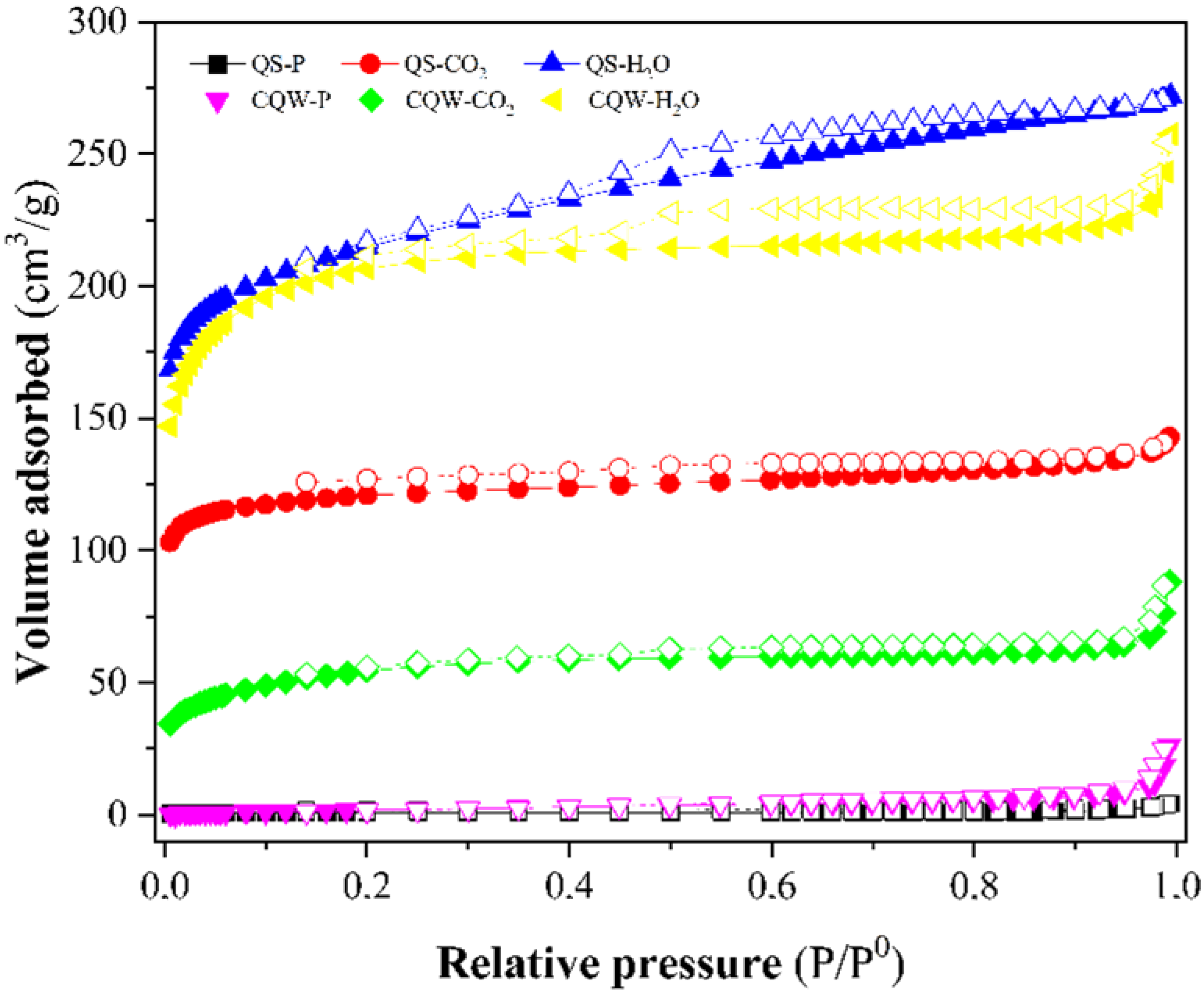

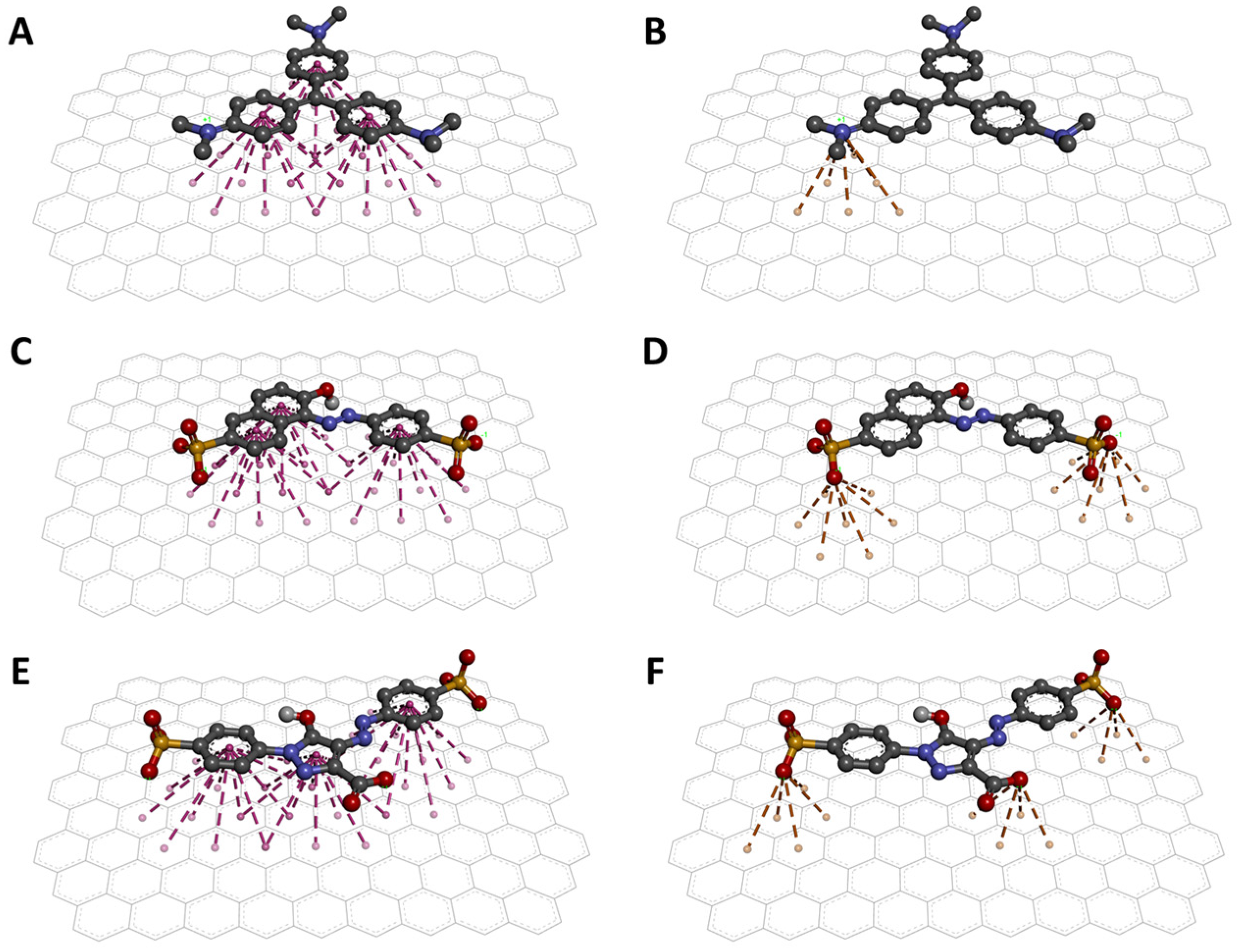

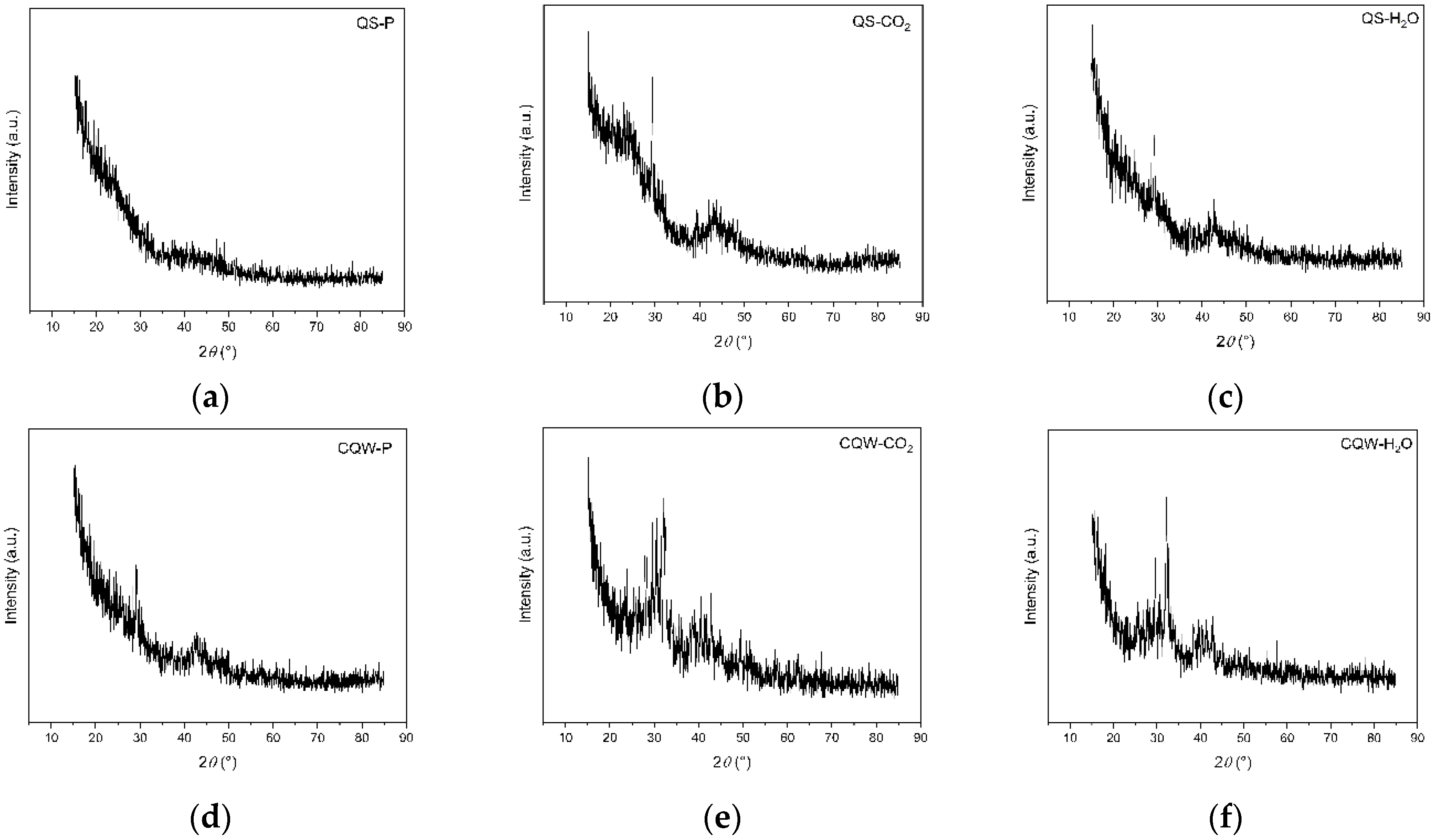
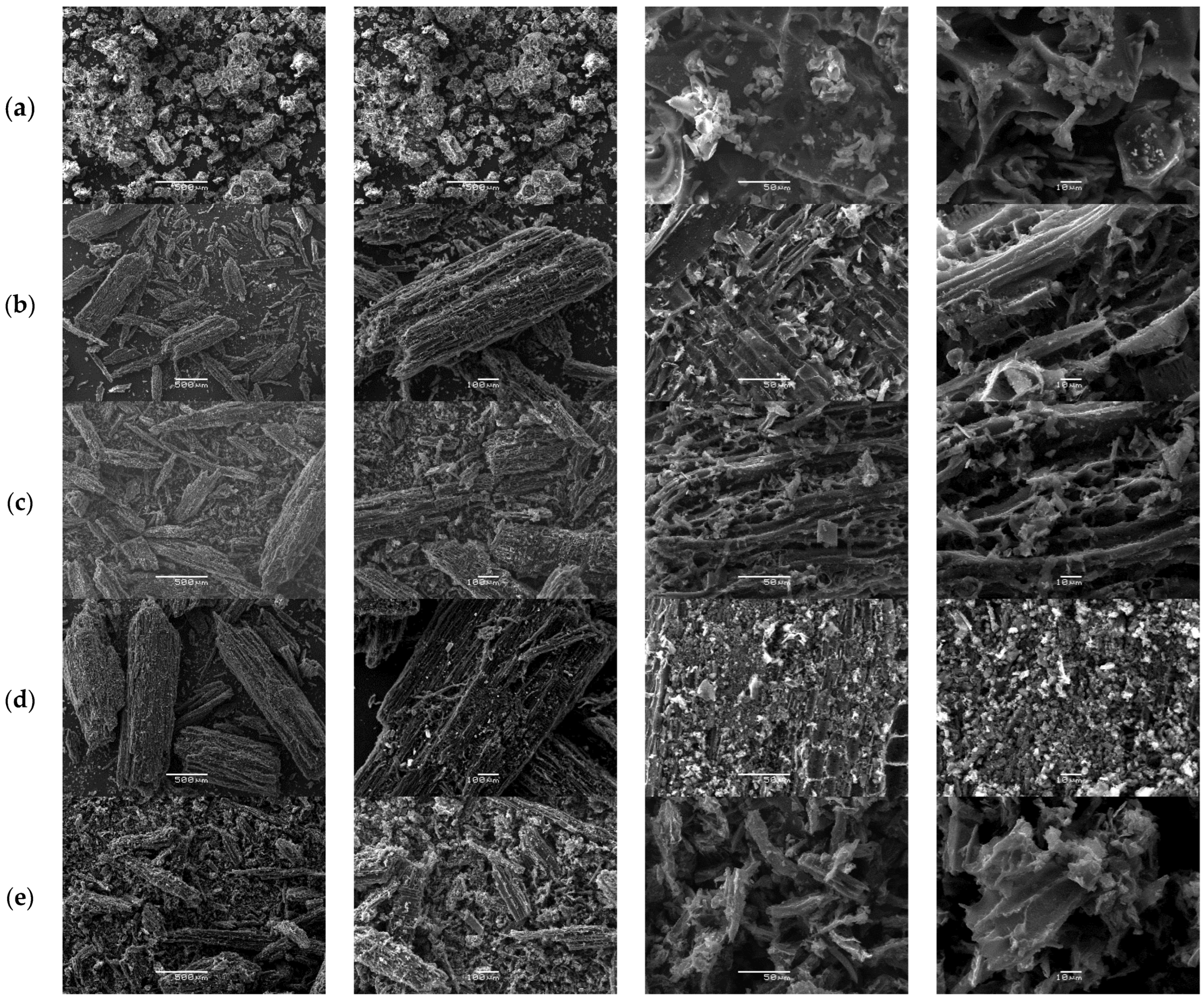
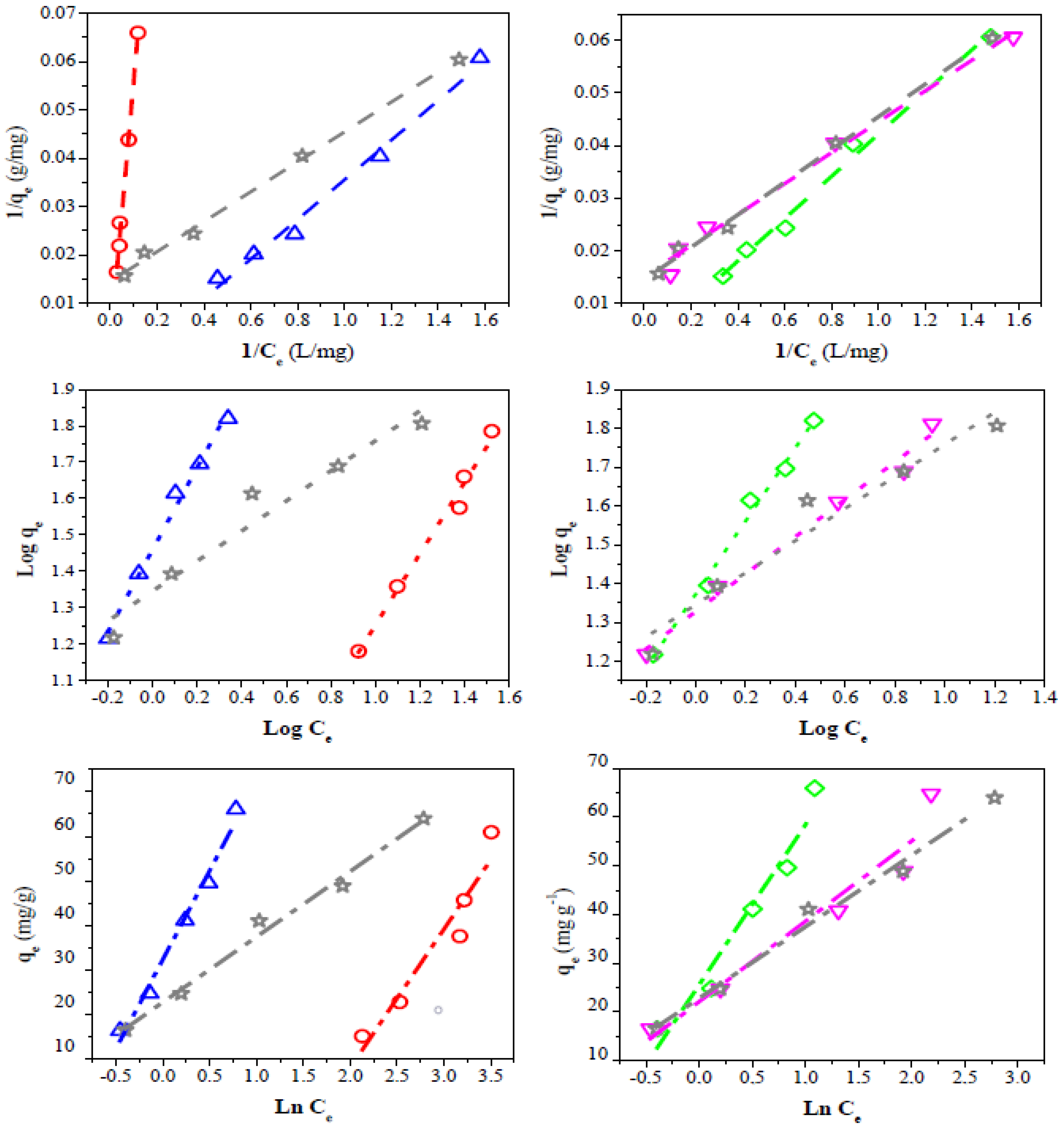
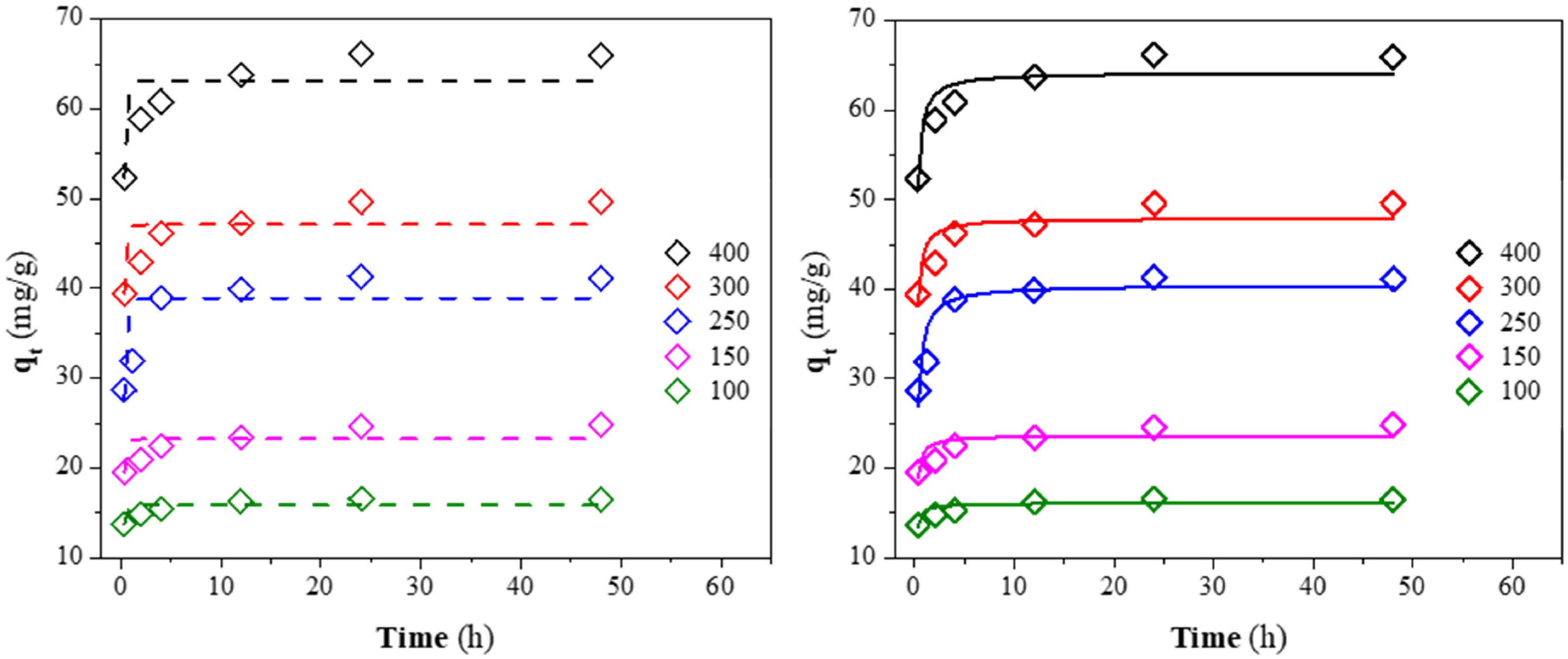
| Time-min | Dye Concentration-mg/L |
|---|---|
| 120 (1) | 400 (1) |
| 20 (−1) | 400 (1) |
| 120 (1) | 100 (−1) |
| 20 (−1) | 100 (−1) |
| 70 (0) | 250 (0) |
| 70 (0) | 250 (0) |
| 70 (0) | 250 (0) |
| Sample | Proximate Analysis-wt. % | Ultimate Analysis-wt. % | |||||
|---|---|---|---|---|---|---|---|
| Moisture | Ash | Volatiles | Fixed Carbon a | C | H | N | |
| CQW | 10.84 | 15.19 | 84.49 | 0.32 | 47.74 | 6.33 | 1.63 |
| QS | 10.36 | 2.26 | 87.93 | 9.81 | 49.20 | 6.32 | 0.40 |
| CQW-P | 8.54 | 44.05 | 33.98 | 21.97 | 50.57 | 2.33 | 1.68 |
| QS-P | 3.45 | 3.46 | 28.38 | 68.15 | 84.55 | 3.32 | 0.95 |
| CQW-CO2 | 10.11 | 50.03 | 28.92 | 21.05 | 46.08 | 0.96 | 1.89 |
| QS-CO2 | 5.39 | 10.74 | 14.69 | 74.57 | 86.69 | 1.22 | 1.34 |
| CQW-H2O | 0.79 | 71.39 | 19.48 | 9.13 | 31.93 | 0.96 | 0.65 |
| QS-H2O | 0.49 | 12.29 | 18.12 | 69.59 | 83.04 | 0.90 | 0.98 |
| Sample | SBET-m2/g | Vtot-cm3/g | D a-nm | Y-% | pH | Iodine Number-mg/g | NH3 Adsorption Capacity-mmol/g |
|---|---|---|---|---|---|---|---|
| QS-P | 3 | 0.006 | 7.92 | 26.0 | 7.98 | 119 | 4.14 |
| QS-CO2 | 479 | 0.219 | 1.83 | 21.1 | 8.14 | 294 | 6.50 |
| QS-H2O | 813 | 0.420 | 2.06 | 17.2 | 10.61 | 619 | 6.50 |
| CQW-P | 9 | 0.039 | 14.08 | 28.2 | 11.34 | 215 | 2.74 |
| CQW-CO2 | 199 | 0.135 | 2.52 | 19.0 | 11.07 | 279 | 0.91 |
| CQW-H2O | 798 | 0.395 | 1.90 | 20.2 | 11.42 | 522 | 5.03 |
| Dye | Sample | Maximum Dye Remotion- mg/L dye/mg Charcoal |
|---|---|---|
| Tartrazine | AC | 9.65 |
| QS-P | 6.68 | |
| QS-CO2 | 3.22 | |
| QS-H2O | 8.01 | |
| CQW-P | 8.08 | |
| CQW-CO2 | 7.55 | |
| CQW-H2O | 7.26 | |
| Crystal violet | AC | 7.06 |
| QS-P | 3.11 | |
| QS-CO2 | 8.99 | |
| QS-H2O | 11.21 | |
| CQW-P | 6.60 | |
| CQW-CO2 | 11.77 | |
| CQW-H2O | 12.67 | |
| Sunset yellow FCF | AC | 10.44 |
| QS-P | 4.21 | |
| QS-CO2 | 4.45 | |
| QS-H2O | 8.13 | |
| CQW-P | 7.21 | |
| CQW-CO2 | 6.66 | |
| CQW-H2O | 6.96 |
| Sample | Langmuir | Freundlich | Temkin | |||||||
|---|---|---|---|---|---|---|---|---|---|---|
| qmax- mg/g | KL- L/mg | RL | R2 | KF- (mg g−1)*(L mg−1)n | n | R2 | a | b | R2 | |
| QS-H2O | −181.16 | −0.1345 | −0.0189 | 0.986 | 28.7614 | 0.89 | 0.987 | 32.342 | 39.856 | 0.981 |
| QS-CO2 | 854.70 | 0.0021 | 0.5374 | 0.992 | 1.8745 | 1.02 | 0.983 | −53.985 | 31.057 | 0.903 |
| CQW-CO2 | 490.19 | 0.0509 | 0.0468 | 0.989 | 23.6037 | 1.06 | 0.988 | 25.543 | 32.817 | 0.942 |
| CQW-P | 65.96 | 0.5172 | 0.0048 | 0.985 | 21.2956 | 2.08 | 0.981 | 22.059 | 16.517 | 0.926 |
| AC | 69.15 | 0.4667 | 0.0053 | 0.995 | 22.1554 | 2.42 | 0.931 | 22.772 | 14.691 | 0.985 |
| Sample | C0- mg/L | qe- mg/g | Pseudo-First Order Model | Pseudo-Second Order Model | ||||||
|---|---|---|---|---|---|---|---|---|---|---|
| qe,c- mg/g | k1- h−1 | R2 | χ2 | qe,c- mg/g | k2- mg/(g h) | R2 | χ2 | |||
| QS-H2O | 100 | 16.45 | 16.46 | 10.917 | 0.7678 | 0.0089 | 16.49 | 6.1559 | 0.8500 | 0.0057 |
| 150 | 24.77 | 24.67 | 6.341 | 0.9883 | 0.0174 | 24.88 | 0.8327 | 0.9923 | 0.0114 | |
| 250 | 41.18 | 38.91 | 3.758 | 0.4680 | 16.0266 | 40.55 | 0.1457 | 0.8130 | 5.6329 | |
| 300 | 49.56 | 47.07 | 4.479 | 0.5495 | 13.0872 | 48.31 | 0.1689 | 0.7646 | 6.8389 | |
| 400 | 66.08 | 62.72 | 4.468 | 0.5936 | 20.0224 | 64.33 | 0.1281 | 0.8009 | 9.8069 | |
| QS-CO2 | 100 | 15.16 | 14.22 | 6.4266 | 0.2156 | 0.9785 | 14.42 | 1.1921 | 0.4079 | 0.7386 |
| 150 | 22.83 | 19.99 | 3.6234 | 0.3775 | 7.2766 | 20.88 | 0.2369 | 0.6122 | 4.5328 | |
| 250 | 37.57 | 32.95 | 4.6316 | 0.1851 | 17.7727 | 34.16 | 0.2302 | 0.4486 | 12.0236 | |
| 300 | 45.68 | 40.77 | 3.6749 | 0.4330 | 24.4524 | 42.51 | 0.1205 | 0.6849 | 13.5903 | |
| 400 | 60.91 | 53.50 | 3.9003 | 0.3003 | 55.7032 | 55.73 | 0.0984 | 0.5394 | 36.6687 | |
| CQW-CO2 | 100 | 16.50 | 15.89 | 5.9857 | 0.5160 | 0.6141 | 16.11 | 0.9654 | 0.7169 | 0.3592 |
| 150 | 24.81 | 23.23 | 5.4720 | 0.4139 | 2.5839 | 23.67 | 0.5141 | 0.6311 | 1.6262 | |
| 250 | 41.12 | 38.89 | 3.7271 | 0.5177 | 13.8297 | 40.47 | 0.1485 | 0.8497 | 4.3098 | |
| 300 | 49.62 | 47.11 | 5.4328 | 0.5194 | 7.7132 | 47.93 | 0.2587 | 0.7223 | 4.4561 | |
| 400 | 65.95 | 63.09 | 5.2964 | 0.6299 | 10.2077 | 64.18 | 0.1869 | 0.8100 | 5.2392 | |
| CQW-P | 100 | 16.51 | 16.39 | 8.6822 | 0.8979 | 0.0152 | 16.46 | 2.8637 | 0.9676 | 0.0048 |
| 150 | 24.71 | 24.23 | 7.6611 | 0.7543 | 0.1810 | 24.38 | 1.2923 | 0.8844 | 0.0852 | |
| 250 | 40.78 | 40.78 | 7.6414 | 0.9821 | 0.0308 | 41.04 | 0.8376 | 0.9441 | 0.0963 | |
| 300 | 48.86 | 48.27 | 8.3843 | 0.8689 | 0.2124 | 48.49 | 0.8659 | 0.9571 | 0.0695 | |
| 400 | 64.75 | 64.33 | 7.4949 | 0.9169 | 0.4149 | 64.72 | 0.4754 | 0.9871 | 0.0644 | |
| AC | 100 | 16.55 | 16.06 | 2.4353 | 0.9154 | 0.7329 | 16.79 | 0.2100 | 0.9895 | 0.0910 |
| 150 | 24.71 | 23.37 | 0.5264 | 0.7675 | 9.0488 | 24.49 | 0.0405 | 0.9089 | 3.5443 | |
| 250 | 41.06 | 38.36 | 0.7627 | 0.7223 | 31.6107 | 40.80 | 0.0283 | 0.8867 | 12.9003 | |
| 300 | 48.86 | 46.69 | 0.4442 | 0.9161 | 16.1052 | 49.79 | 0.0144 | 0.9686 | 6.0317 | |
| 400 | 63.97 | 61.87 | 0.4512 | 0.9247 | 25.6784 | 65.96 | 0.0110 | 0.9709 | 9.8885 | |
Publisher’s Note: MDPI stays neutral with regard to jurisdictional claims in published maps and institutional affiliations. |
© 2022 by the authors. Licensee MDPI, Basel, Switzerland. This article is an open access article distributed under the terms and conditions of the Creative Commons Attribution (CC BY) license (https://creativecommons.org/licenses/by/4.0/).
Share and Cite
Abril, D.; Ferrer, V.; Mirabal-Gallardo, Y.; Cabrera-Barjas, G.; Segura, C.; Marican, A.; Pereira, A.; Durán-Lara, E.F.; Valdés, O. Comparative Study of Three Dyes’ Adsorption onto Activated Carbon from Chenopodium quinoa Willd and Quillaja saponaria. Materials 2022, 15, 4898. https://doi.org/10.3390/ma15144898
Abril D, Ferrer V, Mirabal-Gallardo Y, Cabrera-Barjas G, Segura C, Marican A, Pereira A, Durán-Lara EF, Valdés O. Comparative Study of Three Dyes’ Adsorption onto Activated Carbon from Chenopodium quinoa Willd and Quillaja saponaria. Materials. 2022; 15(14):4898. https://doi.org/10.3390/ma15144898
Chicago/Turabian StyleAbril, Diana, Victor Ferrer, Yaneris Mirabal-Gallardo, Gustavo Cabrera-Barjas, Cristina Segura, Adolfo Marican, Alfredo Pereira, Esteban F. Durán-Lara, and Oscar Valdés. 2022. "Comparative Study of Three Dyes’ Adsorption onto Activated Carbon from Chenopodium quinoa Willd and Quillaja saponaria" Materials 15, no. 14: 4898. https://doi.org/10.3390/ma15144898









